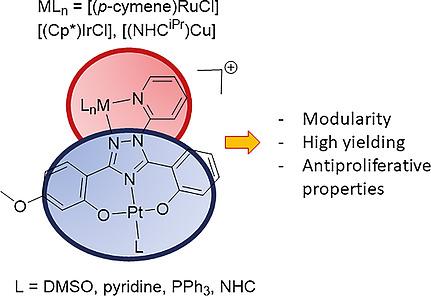当前位置:
X-MOL 学术
›
Eur. J. Inorg. Chem.
›
论文详情
Our official English website, www.x-mol.net, welcomes your
feedback! (Note: you will need to create a separate account there.)
Pincer-based heterobimetallic Pt(II)/Ru(II), Pt(II)/Ir(III) and Pt(II)/Cu(I) complexes: synthesis and evaluation antiproliferative properties
European Journal of Inorganic Chemistry ( IF 2.2 ) Pub Date : 2020-09-09 , DOI: 10.1002/ejic.202000717 Benoît Bertrand 1 , Geoffrey Gontard 2 , Candice Botuha 2 , Michèle Salmain 2
European Journal of Inorganic Chemistry ( IF 2.2 ) Pub Date : 2020-09-09 , DOI: 10.1002/ejic.202000717 Benoît Bertrand 1 , Geoffrey Gontard 2 , Candice Botuha 2 , Michèle Salmain 2
Affiliation

|
Platinum pincer‐based complexes [(O^N^O)Pt(L)] (L = DMSO, pyridine, triphenylphosphine or 1,3‐dimethylbenzimidazol‐2‐ylidene) carrying an (N^N) coordination site were used as starting materials to synthesize a series of seven cationic heterobimetallic Pt(II)/Ru(II), Pt(II)/Ir(III), and Pt(II)/Cu(I) presenting a [(p‐cymene)RuCl]+, a [(Cp*)IrCl]+ (Cp* = η5‐pentamethylcyclopentadienyl), and a [(NHCiPr)Cu]+ {NHCiPr = 1,3‐bis(2,6‐diisopropylphenyl)imidazole‐2‐ylidene} moiety, respectively. The X‐ray structure of one of the bimetallic Pt(II)/Ir(III) complexes showed a distortion of the organic platform to accommodate the coordination geometry of both metal centers, as already observed for previous Pt(II)/Re(I) complexes. The antiproliferative activity of the complexes was first screened on the triple negative breast cancer cell line MDA‐MB‐231. Then the IC50 of the most active candidates was determined on a wider panel of human cancer cells (MDA‐MB‐231, MCF‐7 and A2780) as well as on a non‐tumorigenic cell line (MCF‐10A). The most toxic compound, namely the Pt(II)/Cu(I) heterobimetallic complex 4c, showed antiproliferative activity down to the nanomolar level.
中文翻译:

基于钳子的异质双金属 Pt(II)/Ru(II)、Pt(II)/Ir(III) 和 Pt(II)/Cu(I) 配合物:合成和评估抗增殖特性
基于铂钳的配合物 [(O^N^O)Pt(L)](L = DMSO、吡啶、三苯基膦或 1,3-二甲基苯并咪唑-2-亚基),带有 (N^N) 配位位点被用作起始合成一系列具有 [(p-cymene)RuCl]+ 的七种阳离子异质双金属 Pt(II)/Ru(II)、Pt(II)/Ir(III) 和 Pt(II)/Cu(I) 的材料, [(Cp*)IrCl]+ (Cp* = η5-五甲基环戊二烯基) 和 [(NHCiPr)Cu]+ {NHCiPr = 1,3-双(2,6-二异丙基苯基)咪唑-2-亚基}部分, 分别。一种双金属 Pt(II)/Ir(III) 配合物的 X 射线结构显示出有机平台的扭曲以适应两个金属中心的配位几何,正如之前的 Pt(II)/Re(I) ) 复合体。该复合物的抗增殖活性首先在三阴性乳腺癌细胞系 MDA-MB-231 上进行筛选。然后,在更广泛的人类癌细胞组(MDA-MB-231、MCF-7 和 A2780)以及非致瘤细胞系(MCF-10A)上测定了最活跃候选者的 IC50。毒性最强的化合物,即 Pt(II)/Cu(I) 异双金属配合物 4c,显示出低至纳摩尔水平的抗增殖活性。
更新日期:2020-09-09
中文翻译:

基于钳子的异质双金属 Pt(II)/Ru(II)、Pt(II)/Ir(III) 和 Pt(II)/Cu(I) 配合物:合成和评估抗增殖特性
基于铂钳的配合物 [(O^N^O)Pt(L)](L = DMSO、吡啶、三苯基膦或 1,3-二甲基苯并咪唑-2-亚基),带有 (N^N) 配位位点被用作起始合成一系列具有 [(p-cymene)RuCl]+ 的七种阳离子异质双金属 Pt(II)/Ru(II)、Pt(II)/Ir(III) 和 Pt(II)/Cu(I) 的材料, [(Cp*)IrCl]+ (Cp* = η5-五甲基环戊二烯基) 和 [(NHCiPr)Cu]+ {NHCiPr = 1,3-双(2,6-二异丙基苯基)咪唑-2-亚基}部分, 分别。一种双金属 Pt(II)/Ir(III) 配合物的 X 射线结构显示出有机平台的扭曲以适应两个金属中心的配位几何,正如之前的 Pt(II)/Re(I) ) 复合体。该复合物的抗增殖活性首先在三阴性乳腺癌细胞系 MDA-MB-231 上进行筛选。然后,在更广泛的人类癌细胞组(MDA-MB-231、MCF-7 和 A2780)以及非致瘤细胞系(MCF-10A)上测定了最活跃候选者的 IC50。毒性最强的化合物,即 Pt(II)/Cu(I) 异双金属配合物 4c,显示出低至纳摩尔水平的抗增殖活性。











































 京公网安备 11010802027423号
京公网安备 11010802027423号